On a cruise around the Caribbean, the third port of call stop was at the tiny (112 square miles) island of Bonaire. Berthing at Kralendijk, the capital, we immediately headed off on a pre-booked mini submarine tour over a coral reef – on close-by Little Bonaire Island.

Mini submarine tour to the Coral Reef.
This was a short, but interesting, experience, taking only an hour which meant we still had plenty of time on our hands. Walking back to the ship we stopped and chatted to local Bonaire tourist operators who were lined along the road offering various short trips.
So…against our usual rule of “ship only” organised tours we decided to take the one that explored the southern end of the island for only $US20. Best thing we’ve ever done!
Table of Contents
Last Seat Available
We’d snared the last two tickets and the tour was about to start, so, along with the travel operator we jogged (sort of) to the waiting vehicle. A mini bus was our expectation, but no….it was an old army vehicle – a bit like a long jeep!
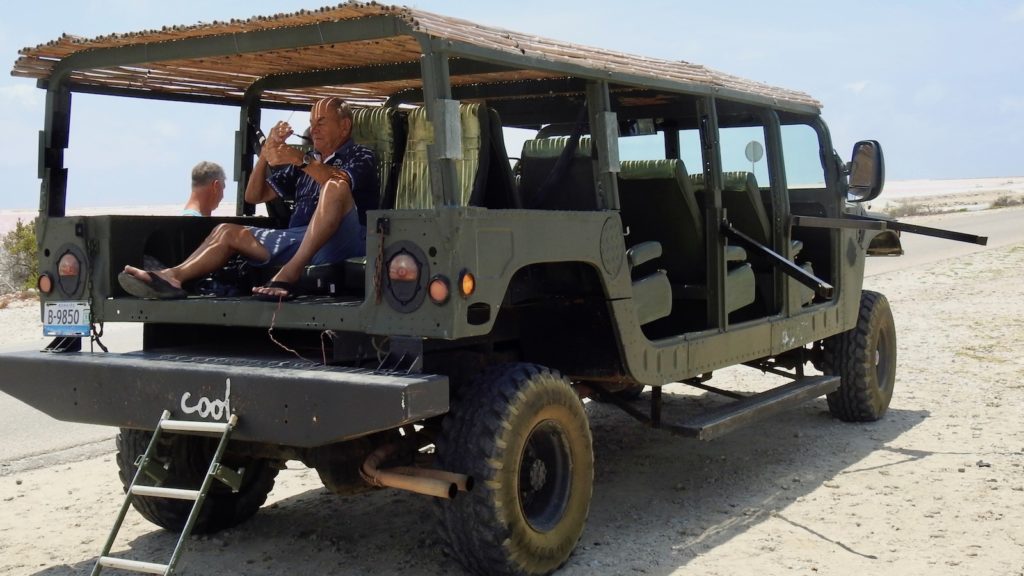
Tour vehicle!
More surprises – as we were last (and of course it’s always first in best dressed on these tours), the remaining seats were in the back, actually facing backwards, and no tailgate on the vehicle! After a fight with the seat belts we gave up and hung on to whatever we could find.
Life’s an adventure right! (Although I’m not sure our insurance company would agree).
First Stop, the Salt Mines of Bonaire in the Caribbean
Out of the flat landscape loomed these albino looking pyramids of salt – about 50 feet high. Each pyramid contained approximately 10,000 tons of almost pure salt waiting to be shipped off to the rest of the world – mainly for water softeners and swimming pools.
Quite a sight in the middle of a dry and arid landscape.
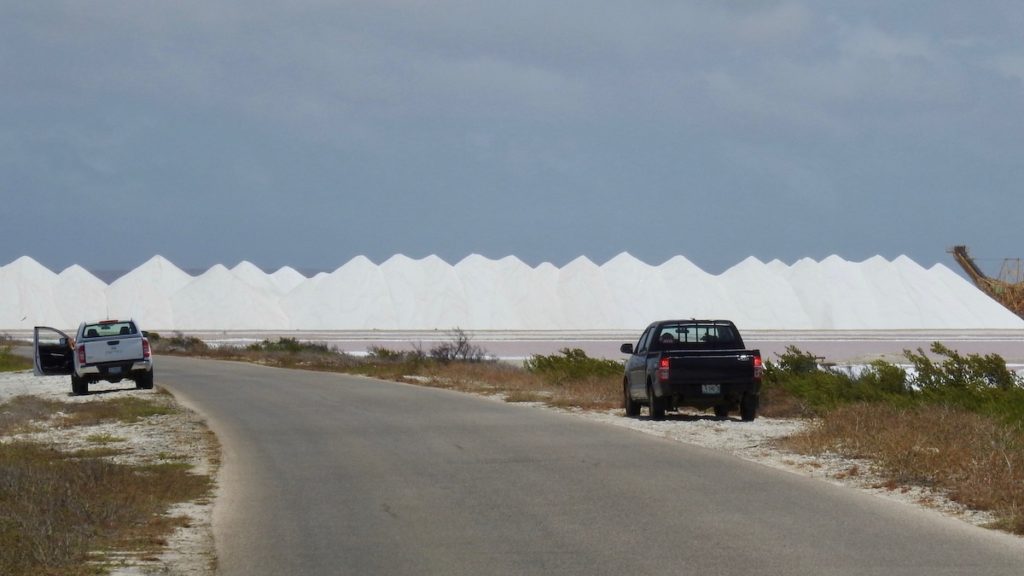
Salt Stacks – Bonaire in the Caribbean
(NB – The Caribbean Islands conjure up a vision of tropical and lush countryside, but this wasn’t actually the case. All islands visited had their green areas, but there was also lots of bare landscape with the bulk of the greenery being cactuses.)
Slave Huts of Bonaire
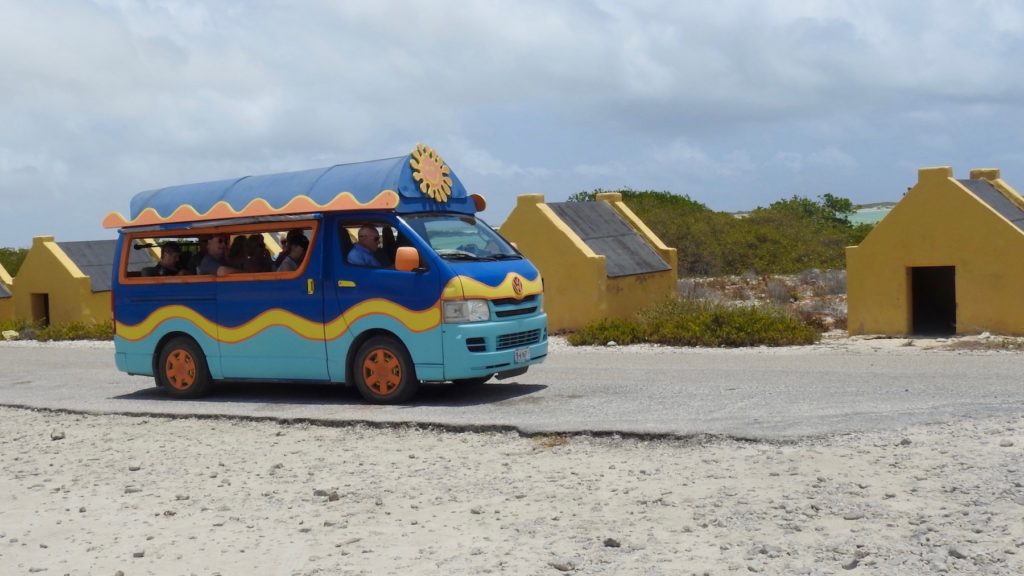
Mini Tour bus and Slave Huts, Bonaire.
While these little huts look fascinating, once you’ve heard the history behind them, it all becomes a bit depressing. Still history is history and facts are facts.
Dating back as far as the 1600s, African slaves were exchanged for “Rum” and taken to Bonaire by the Dutch East India Company to help in the cultivation and harvesting of the island’s most important natural resource – salt.
The workers stayed in these little huts all week and walked for seven hours across the island to see family after work on Friday. Sunday night saw them trek back for work on Monday!
You can’t even stand up in these huts and yet up to six people slept in them…such terrible cramped conditions. (History can be tough to learn at times).
The huts have been restored, but the concrete structures are original – the roofs have been replaced and the walls painted.
Flamingos of Bonaire
We had been told about the Flamingo Sanctuary and had high hopes of seeing many of these beautiful birds. Sadly, this wasn’t the case as we weren’t allowed on to the sanctuary but there are hundreds of them and many tourists are lucky enough to see a lot.

The Flamingos we didn’t see! (Unknown photographer)
But…as luck would have it we did get up close and personal to a rogue young Flamingo who was still growing into his colourful feathers.

Young Flamingo, Bonaire near the salt flats.
This little guy was between 1 – 2 years old because the eyes have changed from grey to yellow and you can still some spots of grey feathers along his neck. (Flamingos only have grey plumage when they are young.)
Interestingly, the older Flamingos get their colour from the beta-carotene in the crustaceans and plankton that is found in the salt flats. (Now that’s a thought, maybe if we all started eating plankton we wouldn’t need to go to the hairdressers for colouring our grey hairs!)
Sorobon Beach Resort at Lac Beach, Bonaire in the Caribbean
Then it was time for a pit stop at the Sorobon Beach (and Wellness) Resort on the eastern side of the Island. We’d headed south, driven around the bottom and were now heading up the east coast.
This laid back resort was absolute beachfront – not high rise but a lot of individual cabin type houses. People were lazing back in low beach chairs on the water’s edge, others chose swimming, paddle boarding, learning the basics of wind surfing or just floating around in the “oh so blue” sea.

Sorobon Beach Resort, in the Caribbean – windsurfer boards ready and waiting.
Sorobon Beach Resort invites everyone “who searches for unrefined enjoyment in nature and unconditional love for serenity”. If you couldn’t find that there – just give up!
Oh, I did see my favourite Caribbean Goat Curry on the restaurant menu, but there was no time to stop and enjoy.
After a wander around and a cold drink it was back on the jalopy and off to watch the wind surfers further along at Lac Bay. Now this I could watch all day – the extraordinary talents of these young (and older) people is truly amazing and it was so busy – flying room only, so to speak.
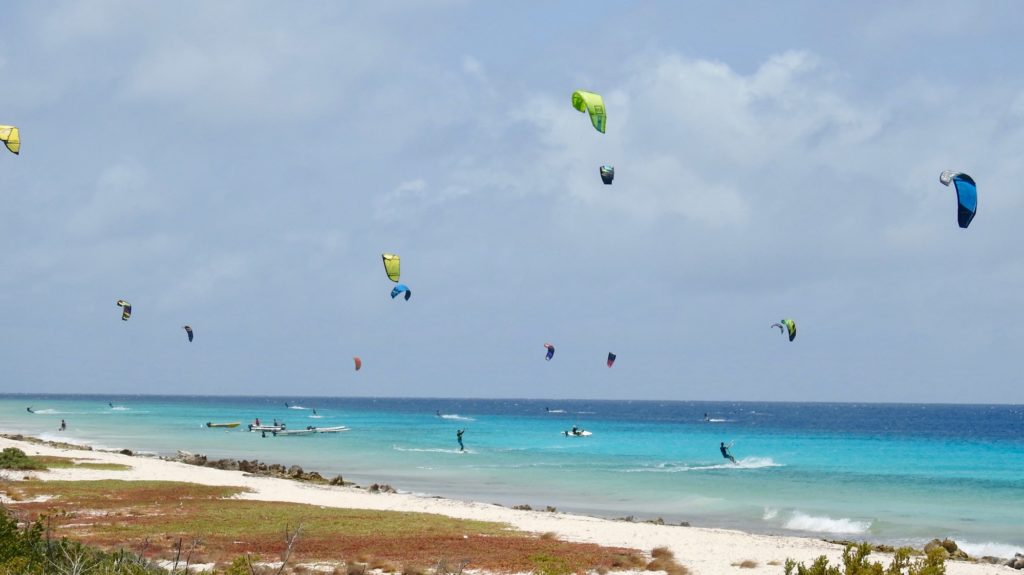
Catching the Wind at Lac Beach, Bonaire.
Lac Bay is a windsurfers paradise because it has steady winds, blue water and perfect windsurfing spots for all levels. We learnt that wind blows in between 10 and 25 knots most of the time, but the weather is warm all year meaning no wind chill.
After dreaming of being young again and catching the wind thermals with a parasail and a board, it was time to head back to our Royal Caribbean ship and have a better story than most to tell about another interesting day in the Caribbean.
Goats and Cactuses
On the way across the Island we saw a lot of fences made out of cactuses. Strange thing you ask? Well, this is to keep the goats out of gardens and eating everything within sight – as goats do. A creative idea that obviously works, and there’s cactus aplenty growing in the island’s interior.
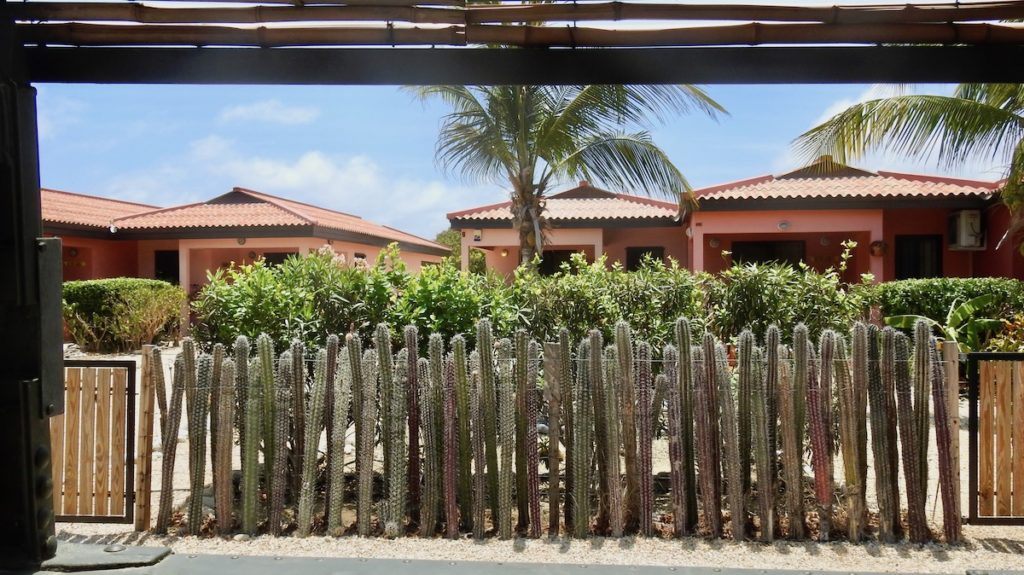
Cactus Fence
Road Sharing with the Locals in Bonaire
Sharing the main “highway” across the island on our way back, we came across more laid back locals (donkeys), who obviously thought they had right of way! A good laugh to finish off our adventurous local tour in Bonaire located in the Central Caribbean that gave us lots to tell our family back home.

Local traffic on Highway in Bonaire !!
Travel Map of Bonaire, in the Caribbean.
Cruise ships land at Kralendijk where all tours (both ship organised and independent) leave from.
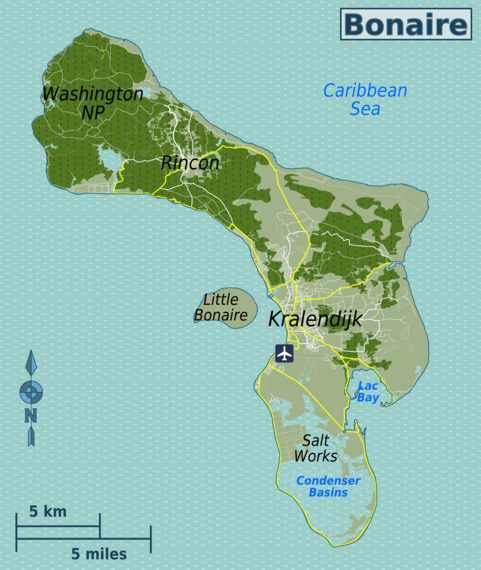
Bonaire travel map.
Handy to know
- Tour of the South Island with local operator – US$20
- Use US currency in Kralendijk.
- The is only small so there’s no risk of getting back to ship late.
- Take your togs/bathers/swimmers and towel for a quick dip in the blue waters.
- Remember the sunscreen and comfortable walking shoes – the surfaces of stops are quite uneven.

Wow Joycee how lucky were you to get the last tickets for this tour on Bonaire Island, even if you had the last seats looking out the back! You really got a great overview of the island. It is far more diverse than I expected. I too thought those slave huts sad. But as you say, history is history and facts are facts. The cactus fences are also novel and interesting – they would keep me out. Overall, it looked a really interesting tour
Hey Estelle, thank you so much for reading my latest post. Bonaire was certainly different and I’m so glad we saw so much of the island. Many tourist operators only take you to the regular hot spots, so was interesting to see the not so lush side! I quickly got used to the limo and it was much more fun than a regular bus:)
The Slave Huts represents a sad past but glad you made it to the tour! A cactus fence – I have never seen one of these “fences” before. A splendid post, Joycee.
I agree with you with the slave huts being a sad insight into days gone past. Wherever we visit in the world there are similar stories – thank goodness live has evolved for these people. Thank you for your comment Georgina – and yes the cactus fences were given a wide berth – LOL.
How fun and looks like an interesting tour. Certainly can’t beat the price either! The donkeys would be a great sight Good post Joycee.
Thank you Christy for your comment. Yes, it was really good fun – so different from any other “tour” we’ve been on. No glitz, but a down to earth experience along with lots of laughs. Can recommend it if you are ever in the Caribbean area. 🙂
What an interesting adventure you had! Sometimes it is so worthwhile to throw caution to the winds and go for it. This time you saw some really fascinating things on your trip.
Yes Roz, the Caribbean was definitely an eye opener. Although not as tropical as I’ve always imagined it would be – with the exception of St Lucia. This tour was hilarious and has given me courage to do more of these local tours when next on a cruise, rather than those organised by the ship. Thank you for your comment. 🙂
This all sounds fabulous Joycee. My type of place! There is so many interesting things to see here – love those flamingoes! I hadn’t even heard of Bonaire before I read your post!
LOL – I hadn’t heard of Bonaire before either! I always thought flamingoes lived in tropical surroundings – because although we were on an island in the Caribbean it wasn’t lush or tropical. Although the sanctuary where the flamingoes were has a a lot go greenery – but that was it. The rest of the island was very dry and arid. The tour was definitely a lot of fun though….thank you for your comment Jenny.